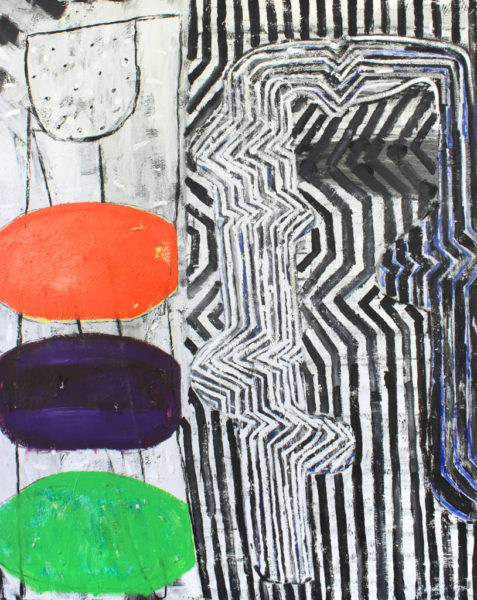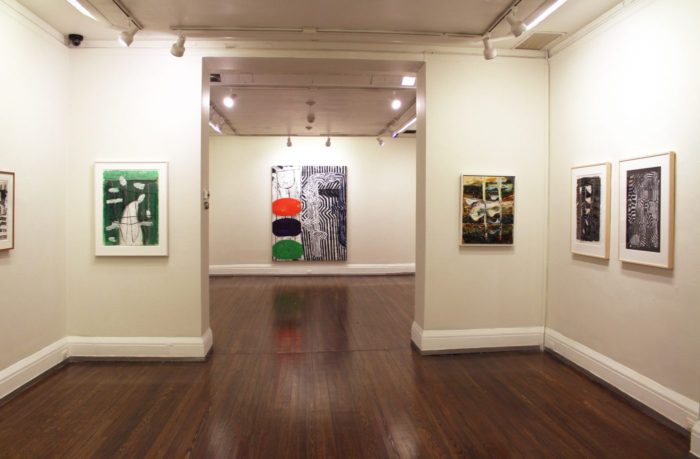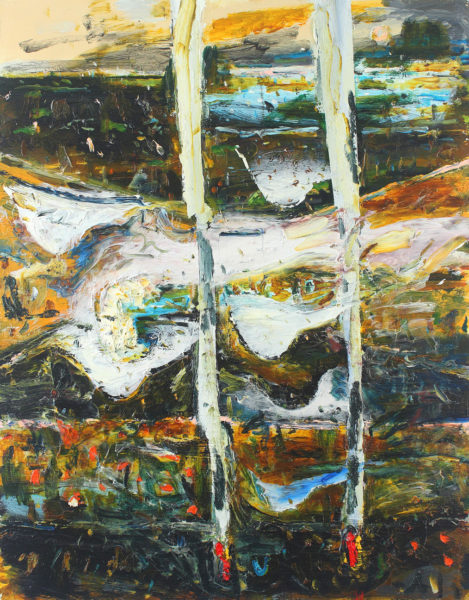
John Walker’s exhibition, entitled “The Sea and the Brush,” is a terrific abstract vision of the scenery, oriented toward the ocean, found in northern New England. British by birth, Walker has long pursued a successful academic career in America; for many years, he was in charge of the MFA program at Boston University (he retired in 2015). Now an octogenarian, Walker continues to paint lively, nonobjective works that nonetheless demonstrate a feeling for water and the coast in Maine. These paintings can remind the viewer of John Marin’s versions of a geographically similar landscape–Marin painted in Maine–but Walker is schematically a bit bolder, if equally lyric. Additionally, his art inevitably demonstrates a contemporaneity not possible to see in Marin’s work, whose modernism at this point feels slightly antiquated. The directness of Walker’s abstractions, highly patterned in their composition and emotionally direct, claim our attention by virtue of their immediacy and their freedom from pretense. Walker seems to have internalized the best of the American painterly spirit–its improvisatory lightness and its irreverence toward tradition. Taken as a group, his canvases and works on paper conduct a trajectory that includes joyousness and spur-of-the-moment decisions, but also a healthy regard for structure based on the actual perception of the landscape. Inevitably, the works should be seen both as abstractions and studies of the sea. At the same time, the show echoes the libertarian spirit of the New York Studio School, still, an art institution noted for its open atmosphere. In its drive toward both form and freedom, “The Sea and the Brush” sets an example for those studying there.

There were more than a few nicely produced works on paper, but the larger paintings, done on canvas, stood out. Move (2017), a strong-willed work of art, consists of a green, dark-blue, and orange lozenge on the left, with a white background broken up by lines, suggestive of weathered wood. This motif dominates the right side, which consists of patterns of black lines, both straight and angled, that rise vertically against a similar whiteness. This large oil on canvas, 84 by 66 inches, shows how good Walker is at evoking the ocean–even if there are no waves or sand to be seen. At the same time, one understands that the compositional affiliations are as abstract as they are indicative of a place. Walker has spent most of his adult life in America, and clearly has internalized the way our modern and contemporary abstractions can reflect, even if only indirectly, a realism originating from actual perception. Art doesn’t always balance out in this fashion; much abstract art remains resolutely abstract. But Walker’s imagination looks at more than one kind of sphere. In Swept In (2017), the arrangement is one of blue stripes and partial chevrons on a canvas exactly the dimensions of Move; down the middle of the painting are five white lozenge shapes, curved downward but with the other end being straight. The title clearly links the painting to the sea. It suggests movement and high tides, both in a celebratory way.


Two Brush Fires, an earlier work from 2013 is smaller: 28 by 22 inches. It is thick with impasto, with a series of rough horizontal levels, the lowest being flecked with a fire-like orange. The painting is further structured by two mostly white vertical stripes, which divide the painting into thirds. The middle of the work is mostly whitish, but blacks and blues and yellows and greens are found throughout the surface. The painting directs us toward its texture as much as it does toward color. And here, too, Walker’s audience finds that he is both opposing and equalizing aspects of painting that by now have been understood and internalized to the point of becoming academic–clearly something he wishes to avoid. By setting up these antinomies, Walker polarizes the elements of painting in order to bring them more fully–and more contemporarily–together. He may, or may not, have done this consciously, but one suspects that such an expert merger of usually clashing elements comes from decades of effort. Fire and Tide (2011-14), a mid-size painting, combines what actually looks like a seascape with low-lying dark clouds and, on the bottom two-thirds of the painting, a series of dark yellow stripes moving vertically against a blue-green background. In the middle of the stripes, we see an anchor- or anvil-like shape, with blue horizontal lines separating yellow bands of color. Like most of the works in the show, the image is poised between pattern and actual vision.


The works on paper, aligned in a row, are mostly black-and-white, but one particularly nice example, Study for Touch (2015), is composed of a dark green background with a lighter green, horizontal band on the top. White blobs dot the composition, with a major white form in the middle; white and black lines, drawn upon them, complicate this lyric painting. Walker is at his best when he re-works American art truisms into something that belongs to our tradition and also escapes it, just so slightly. Today, painting is in a strange place: there is neither a center nor an edge originating a new style. We have been living in a mostly historical situation in all the arts for some time. The trick, then, is not to become scholarly about painting, but rather to make use of former effort and translate it into something that would affect an audience long past amazement in regard to abstract art–especially in New York. Walker does manage to animate a heavily trodden field, but like most successful efforts in abstraction today, his paintings feel slightly isolated. It is clear that formal innovation depends on individual efforts rather than groups or movements; this is especially true in light of the politicized imagination we are involved with at present. But single artists like Walker still manage to keep the language of painting alive, to a point where his idiom moves beyond survival into a world, very much alive, of its own.
John Walker: The Sea and The Brush
December 11, 2017 – Sun, January 21, 2018
New York Studio School
8 W 8th St, New York, NY 10011
-Jonathan Goodman
Image credit: Alexandre gallery & New York Studio School.

I would have loved to see this show ,however travel from the UK was not possible .Reading this wonderfully detailed description really helped and I shall not only read ARTE FUSE regularly ,but also put forward articles and suggested critiques.Absolutely essential reading .Thank you Patrick Jones